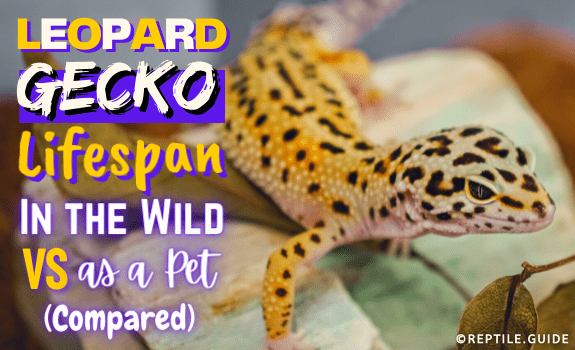The leopard gecko lifespan varies between wild geckos and those in captivity.
In the wild, the common leopard gecko lifespan is around 6 to 8 years.
A pet leopard gecko may live much longer, even up to 20 years!
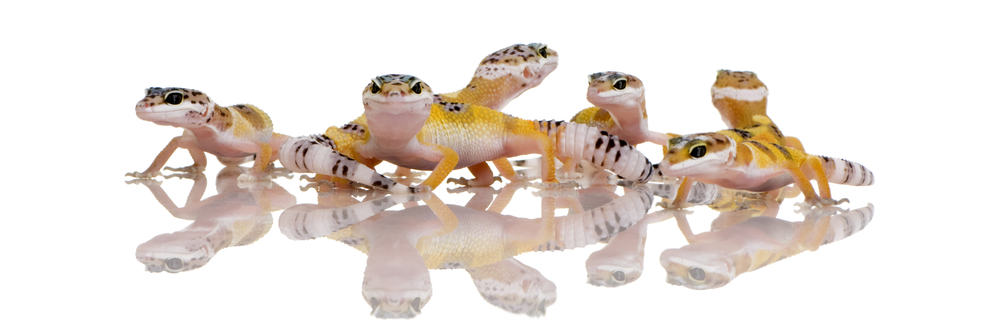
Join us as we take a closer look at the various factors affecting the leopard gecko lifespan.
If well cared for, leopard geckos can live long lives.
In This Article
What Is the Lifespan of a Leopard Gecko?
What is the lifespan of a leopard gecko? A wild leopard gecko that reaches eight years of age has had a long life.
They have many pressures and dangers to contend with that a pet leopard gecko doesn’t have to face.
Predators, parasites, and hunting for food and water are just a few of the factors.
Leopard Gecko Lifespan in Captivity
The leopard gecko lifespan in captivity tends to be much longer.
The average lifespan for most pet leopard geckos is around 15 years.
They have keepers who feed them, ensure access to water and keep temperatures in optimal ranges.
Thanks to the ideal conditions that keep leopard geckos healthy, a fancy leopard gecko lifespan can last for up to 20 years.
Female Leopard Gecko Lifespan Vs. Male Lifespan
Leopard geckos of different sexes have different life expectancies.
When you bring home your baby leopard gecko, you want to find out its gender.
While there are exceptions to the rule, female leopard geckos live shorter lives than male leopard geckos.
Male leopard geckos don’t undergo the stress and energy expenditure of egg production.
Breeding may take time off a female leopard gecko’s lifespan, so your female leopard gecko might live longer if you don’t breed her.
However, to some extent, females undergo many breeding stressors even if they don’t breed. Their bodies still produce eggs at times, but they’re infertile.
The consensus is that male leopard geckos live longer.
The oldest leopard gecko on record was 28 years old and a male.
Factors Affecting a Leopard Gecko’s Lifespan
Many factors affect a leopard gecko’s lifespan, both in captivity and in the wild.
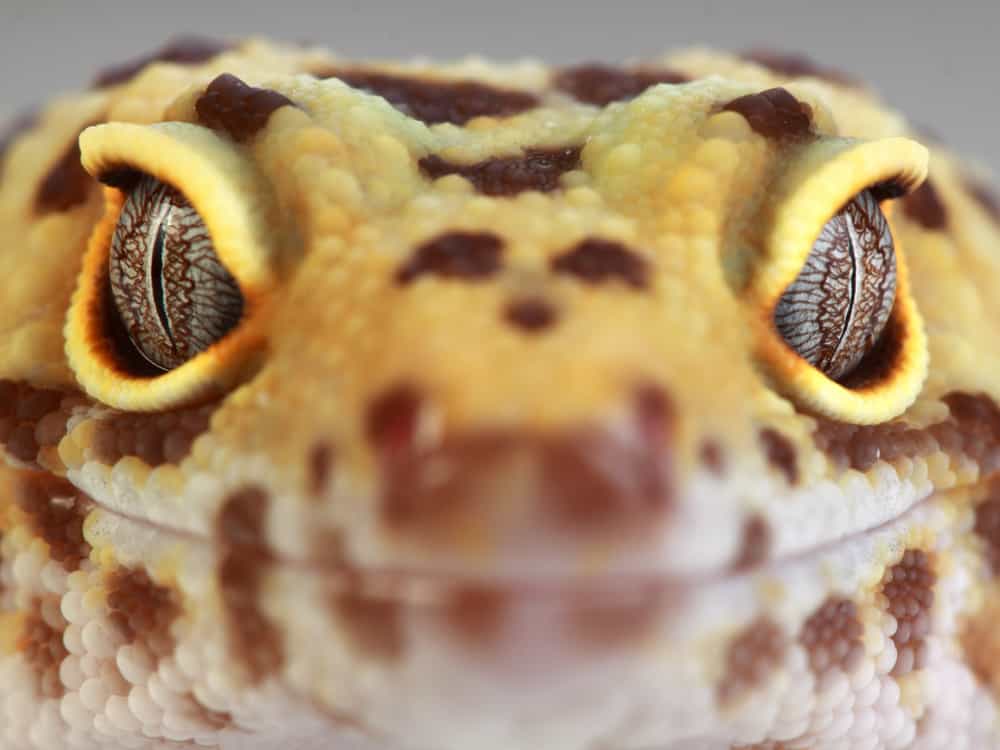
Let’s take a closer look at some main ones:
- Gender – As discussed above, a female leopard gecko doesn’t live as long as a male. In part, it depends on the leopard gecko’s surroundings.
Wild leopard geckos breed every year. In these situations, a female leopard gecko suffers more stress from mating, producing, and laying eggs.
In both the wild and captivity, male leopard geckos live longer, though females may buck the trend and live a long life.
- Predation – Predation isn’t a problem in captivity, but it’s a factor in the life expectancy of wild geckos.
Wild leopard geckos are a reliable food source for many aerial predators.
Both baby and adult leopard geckos are near the bottom of the food chain in the wild.
Eagles, snakes, and rodents are just a few of the many predators that consider leopard geckos a tasty snack.
- Environment – Whether in their natural habitat or the care of pet owners, the environment affects the life expectancy of a leopard gecko.
For example, a wild leopard gecko in a habitat where water is scarce and it’s hard to find food will be less likely to live a long life.
If the habitat is favorable (access to water, enough food, sufficient shelter, etc.), the leopard geckos will live longer lives, barring predator pressures.
Leopard geckos in captivity suffer the effects of their environment too.
When the leopard gecko care is excellent (regular feeding, constant access to fresh water, access to appropriate minerals, etc.), the lizard will live longer.
If the leopard geckos live a neglected life (sporadic feeding, long periods without water, not enough nutrients), the lizard won’t live as long.
- Stress – Stress isn’t only a killer to humans, but it also affects reptiles. Leopard geckos in stressful environments die sooner than lizards with a calm existence.
For wild leopard geckos, stressors might include:
-
- A large population of predators
- Lack of cover and places to shed
- Not enough edible insects
- Water scarcity
- Frequent health problems
- Competition with other lizards of the same species
For a captive leopard gecko, stressors include:
-
- Getting handled a lot
- The lack of a temperature gradient
- Not having access to a day/night light cycle
- Health problems stemming from an unbalanced diet
- The constant presence of natural predators in the room (cats, dogs, parrots, etc.)
- Genetics – Although not many people discuss it, the genetics of your leopard gecko has a significant impact on its life expectancy.
A leopard gecko with strong genetics has better immunity against disease, can better recover better from health problems, and will suffer less stress from breeding.
A leopard gecko that comes from a weak bloodline will be more susceptible to certain diseases and might have a hard time recovering from illnesses.
How to Ensure That Your Pet Leopard Geckos Live Long, Healthy Lives
If you want your leopard gecko to take full advantage of its life expectancy, you need to give it optimal care.
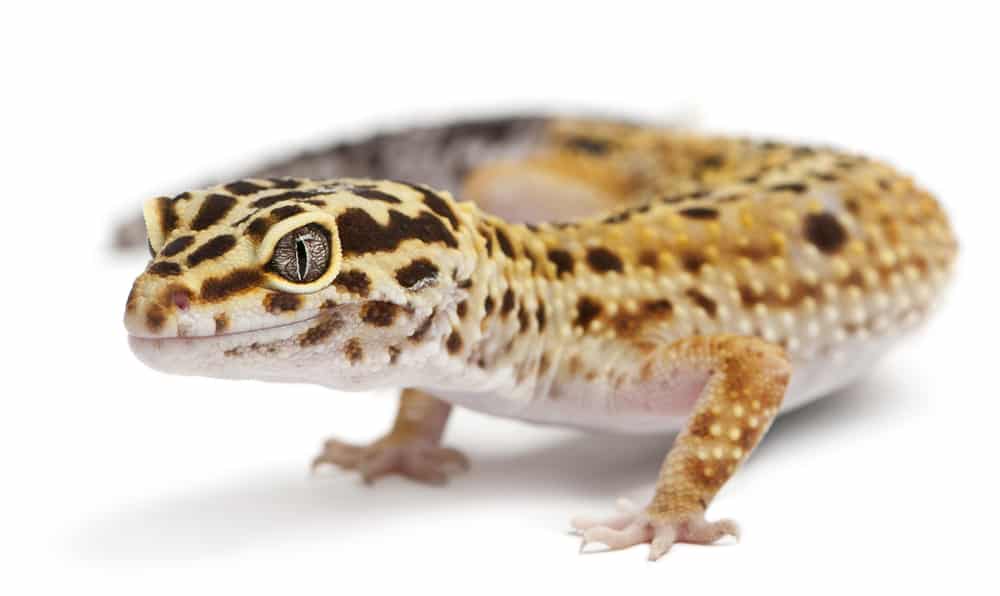
Let’s look at some essential elements for helping a leopard gecko stay healthy:
Feed a Balanced and Varied Diet
Your gecko requires a variety of live foods to stay healthy.
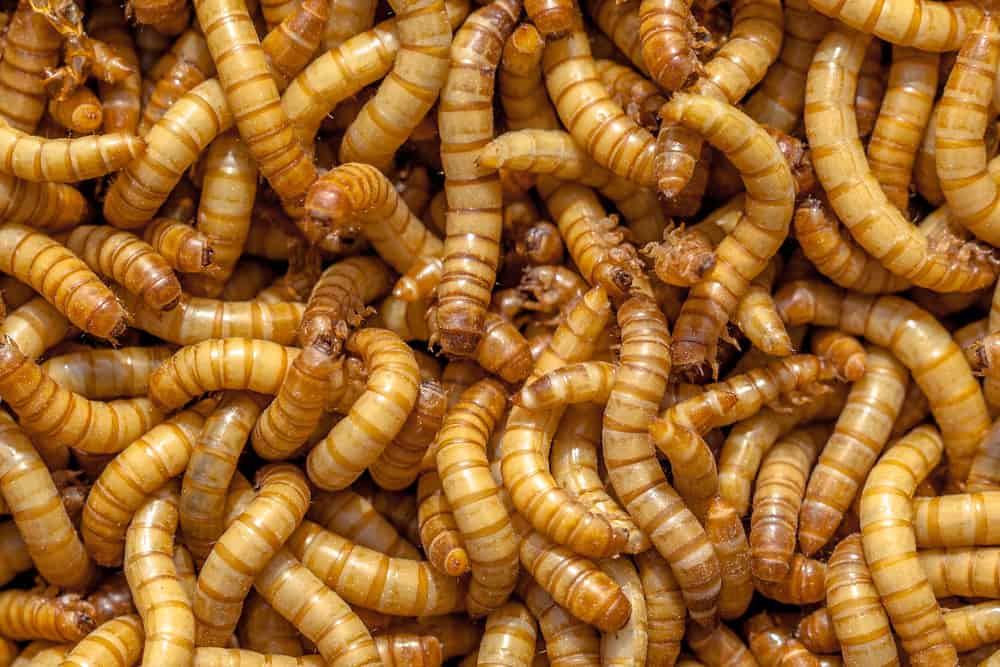
For best results, you can try things like:
- Crickets
- Small superworms
- Black soldier fly larvae
Mealworms contain too much fat to be a healthy food for leopard geckos.
You should avoid waxworms for the same reason.
Black soldier flies only came on the market a few years ago, and new species popped randomly. Keep your eyes peeled for exciting new additions to the market.
It’s essential to use a high-quality calcium supplement for your geckos. It prevents calcium shortages and ensures that your lizard has a balanced diet.
Give Your Leopard Gecko the Right Environment
Ensuring that your leopard gecko has an enclosure, and general environment, where it can feel comfortable will cut down on stress and help it to lead a happier life.
The leopard gecko is a desert species, so giving it a natural substrate (A.K.A. smooth gravel or similar) will help it feel more at home.
Hiding places are another essential element of keeping your leopard gecko feeling safe and happy.
As we mentioned earlier, the leopard gecko is near the bottom of the food chain in the wild. To feel secure, your leopard gecko will need at least one hide.
Appropriate Heating and Lighting
Your leopard gecko will be more active at night, but it needs a day and night cycle to keep it healthy.
Without a day and night cycle, your lizard’s body will not follow its normal biological cycle. This can lead to health issues.
The best solution for your pet is to provide a 12-hour day and 12-hour night light cycle. This way, it has time to eat, drink, and rest.
You need to ensure that your gecko’s enclosure has an appropriate temperature gradient.
Although the leopard gecko isn’t a basking lizard, it still needs a temperature differential.
Since reptiles can’t adjust their body temperature, they moderate it by moving between warm and cool areas.
To keep your leopard gecko healthy, ensure that you only heat one side of the tank. Keep it heated to around 90 °F, with the cool side at around 77 °F.
Breed Your Leopard Geckos With Care
If you decide to breed your leopard gecko, it’s important to be responsible with how you go about it.
Don’t allow the lizards to breed non-stop. Introduce the pair to each other during designated breeding periods.
If you allow your male to breed with your leopard gecko female all the time, her body won’t recover.
Producing the eggs takes a lot out of the female, so it’s best to only breed her once or twice a year.
Although it isn’t as stressful for the male, constant breeding takes a toll on a male leopard gecko.
In some cases, he may become more interested in breeding than eating and drinking. This approach isn’t good for the health of either leopard gecko.
Caring for Older Leopard Geckos
A leopard gecko that’s nearing the end of its life finds it harder and harder to do certain things.
As they age, you need to pay more attention to your leopard gecko’s health.
- Older leopard geckos aren’t as successful at fighting off diseases and infections, so keep a close eye for any signs of illness.
- Compaction is more common in an old gecko, so check that your pets are defecating as normal.
- Depending on its genetics, background, and other factors, a leopard gecko may start losing mobility as it ages.
Ensure that your gecko doesn’t lose the ability to move from one side of the enclosure to the other or get to the food and water bowls.
In these cases, it might be better to move your pet to a smaller enclosure.
- An older gecko is more susceptible to parasites as well, so get your pet tested every year so you can treat any parasite infections that arise.
Health Problems Affecting Life Expectancy
As we mentioned earlier, illnesses, diseases, and the stress that results from them can significantly cut down your leopard gecko’s life expectancy.
Let’s take a look at some of the major problems that may affect your pet reptile.
Stuck Sheds
From time to time, your pet may have problems shedding, or you’ll find its retained skin after the shed. If your lizards are in good health, it shouldn’t be a problem. It can still happen, though.
Possible reasons for stuck shed include:
- Low humidity
- Low temperatures
- Other health conditions
Once the problem has occurred, there are a few ways to deal with it.
You could mist the gecko with lukewarm water and a fine-spray misting bottle. Sometimes, that’s enough to allow the gecko to finish shedding.
Mist the gecko (but not the face) and leave it for around 20-30 minutes before patting it dry.
If the misting technique doesn’t work, try bathing your gecko in lukewarm water for ten minutes. Ensure that the water isn’t higher than your pet’s chin.
After ten minutes, try rubbing the affected areas (be gentle) to see if the remaining skin comes loose. Of course, don’t try this for eyes or other sensitive areas.
Only bathe your lizard if it has stuck shed after more than 20 hours post-shed.
If neither of these techniques works, then it’s time to consider buying a commercial shedding aid. These items contain oils that help separate the shed from the new skin.
For more information, check out our leopard gecko shedding guide and learn more about the process and how you can help.
Malnutrition
Geckos need a balanced diet that consists of more than one or two types of feeders. Malnutrition is the result of an unbalanced diet, and leads to early death.
Like most lizards, geckos need a high calcium diet.
You need to dust the feeders with calcium before feeding to ensure that the geckos get enough calcium.
Impaction
If you keep your gecko on a fine substrate, like sand, it’s at high risk of suffering an intestinal blockage (impaction).
When the reptile swallows a large amount of substrate, it gets stuck in the gut and prevents food from passing through as it should.
Common signs of impaction include:
-
- Straining to defecate
- Lethargy/listlessness
- Anorexia or loss of appetite
To prevent impaction, ensure that you keep your geckos on a substrate that’s too large for them to swallow.
Good options include:
- Reptile carpet
- Stone or slate
- Smooth, medium-sized gravel
Egg Retention
For the most part, these lizards are good layers that don’t have problems with laying eggs.
These reptiles lay two eggs at a time so, if your female lays only one, take her to the vet for scans.
If egg retention has taken place, your pet will require surgery to remove the obstruction. Only a vet can solve this problem.
Abscesses
These reptiles can suffer from abscesses that form under the skin.
The only way to solve the problem is to sedate the lizard and lance the abscess to remove the infection inside.
You’ll need to take your pet to the vet for this procedure. They’ll place the animal on a course of medication and painkillers.
In some cases, it might be necessary for the vet to grow cultures of the bacteria.
This will allow them to identify the bacteria, which helps to treat the problem and prevent a resurgence.
We hope you’ve enjoyed this article about the leopard gecko lifespan. Check out our comprehensive care guide for more information about caring for your pet.
We also have complete guides to the leopard gecko price, leopard gecko diet, setting up the habitat for your gecko, and an article about leopard gecko morphs.
How old is your pet gecko? Let us know in the comments.
